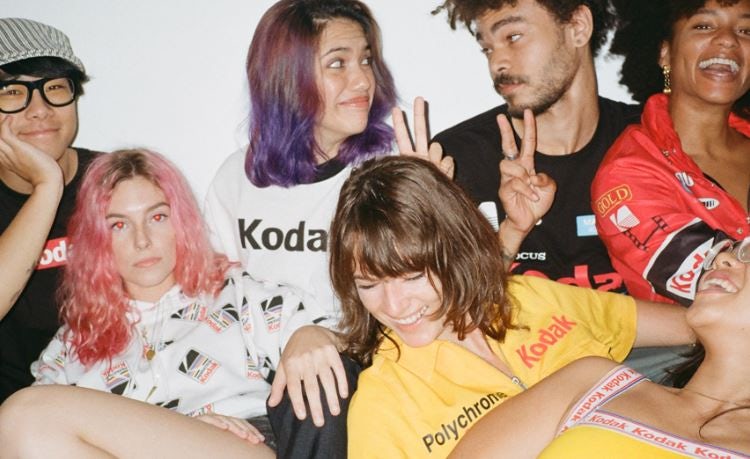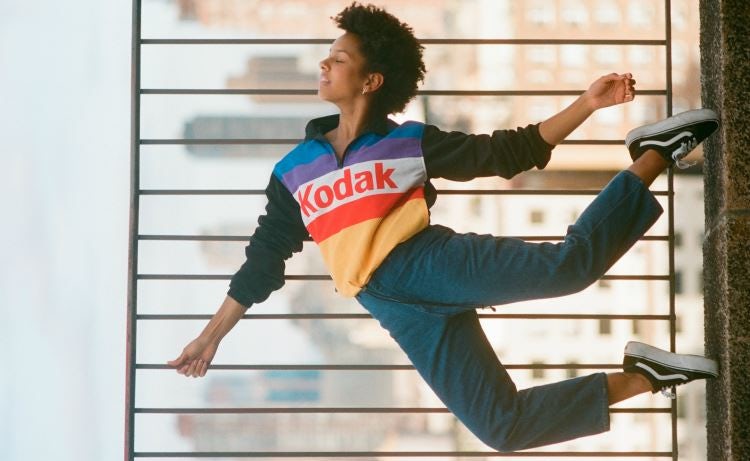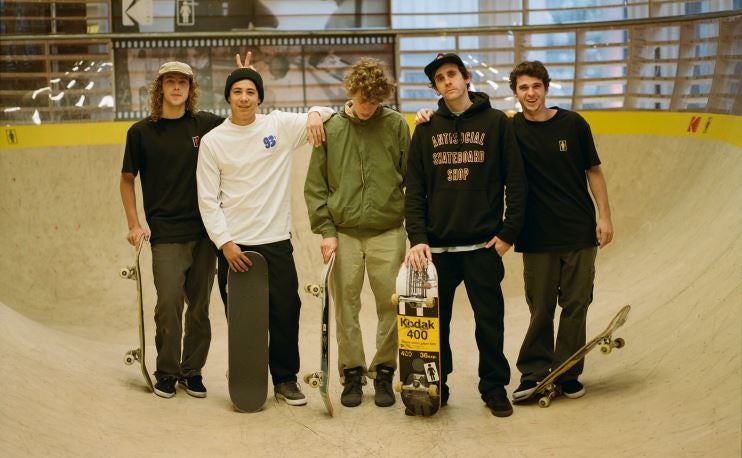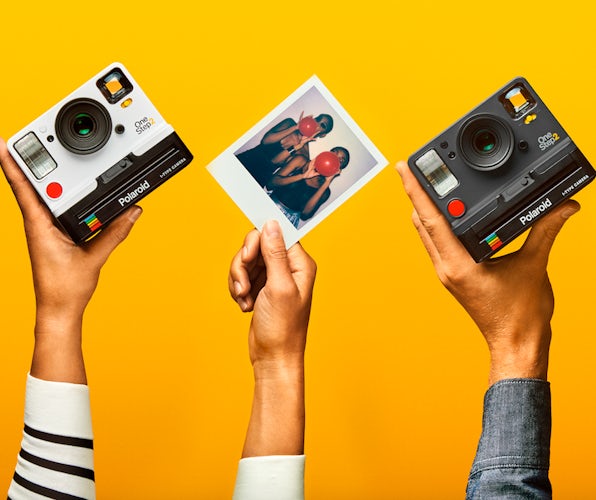From skate to streetwear: Kodak plans to bring back its consumer brand in a ‘big way’
130 years since it was established, camera giant Kodak has a new strategy for success focused on entrepreneurial marketing, cool collaborations and leveraging the brand’s vintage assets to tap into the ‘new nostalgia’.

Kodak is a company in complete transformation. From reinventing the product experience to finding innovative new ways to market, the focus is on bringing the company back to founder George Eastman’s original vision from the 1880s to make photography as simple as using a pencil.
For chief brand officer Dany Atkins, the ambition is for people to know and love the Kodak brand like they did in the past. While the business is currently 80% focused on commercial print technologies, a key part of her role over the past three years has been to bring the consumer brand back in a “big way”.
“Kodak had almost forgotten that it was a massive consumer brand,” she explains.
“We sell technologies into the print industry and that’s the lion’s share of the business, but we’ve been focusing a lot of energy on rebuilding the consumer business by creating our own products and licensing the brand with a very clear strategy for those products to be within the image economy.”
During the 1990s the camera giant, which had once claimed 90% of film and 85% of camera sales in the US, was regularly in the list of the world’s top five most valuable brands. In 1996 Kodak’s revenues peaked at $16bn, clocking up profits of $2.5bn by 1999.
Despite having invented the first digital camera in 1975, the rise of digital and smartphones sparked a difficult two decades for Kodak as mass consumer demand for film cameras crumbled. Between 2003 and 2012 the company closed 13 manufacturing plants and 130 processing laboratories, slashing its workforce by 47,000 and filing for bankruptcy protection in the US.
Now Kodak is in far better shape, with a thriving brand licensing business worth $3m and a consumer division which generated $48m in revenue during the third quarter of 2018.
Whether they are working on the B2B or consumer side of the business, Atkins and her team want to find pockets of space where the Kodak brand can shine, either through new tech, in-house digital businesses or licensee agreements. The future strategy will see Kodak look for more brand relevant categories within which it can develop new startup businesses.
“Essentially its about leveraging the brand and our marketing muscle to create completely new businesses. That’s something that my team and I are quite focused on at the moment,” Atkins explains.
“So building business plans rather than being a traditional marketing team. We’re much more of a business development team using the brand as the core asset and then developing businesses off the strength of the brand, finding partners to do it with or investors.”
One such emerging digital business is Kodakit, a platform used by brands like Uber and Deliveroo to commission photographers for shoots. Photographers register on the platform and then once selected businesses send over the specs for the photoshoot they wish to commission. Once the bespoke shoot is finished the photographer edits the images and uploads them to the Kodakit platform, from where the client downloads the photos.
Kodak manages and processes all the payments and licensing on behalf of the photographer, who has the fee paid straight into their account. The platform also has a back-end AI system which checks all the images before they pass to the client to ensure they are up to standard.
Developed entirely in-house, the platform was launched two years ago in Singapore and has to-date commissioned more than 20,000 individual jobs and shared 300,000 images across 30 countries globally. Kodakit is run as a startup separate to the rest of the company but still wholly owned by Kodak.
The brand’s support of the photographic community extends to collaborating with a host of young, emerging photographers including the likes of Rosie Matheson and Krissy Saleh. Discovering them via Instagram, Kodak supports these photographers through their personal projects, as well as working with them on creating content for the brand.
“Instead of working with agencies our strategy is to do a lot of our creative work in-house and then we work with a lot of talented creators on specific pieces of content,” Atkins explains.
The new nostalgia
Reflecting on modern culture, the chief brand officer admits that until recently the idea of the ‘Kodak moment’ had dropped out of the common lexicon as digital disruption took hold and print became less prevalent in society.
However disruption, Atkins believes, has flipped the other way with young people developing a real passion for modern nostalgia that is helping to fuel demand for instant print, now one of Kodak’s biggest categories.
“People are discovering film and analogue again, and we’ve got this incredible portfolio of products, brand names and graphic design that we can pull from and bring back to life in new ways,” she explains.
The current vogue for all things analogue has paved the way for Kodak to enter the fashion industry, a fast growing sector for the brand. This shift has been powered by collaborations with fashion brands, a strategy Atkins first honed while working as EMEA marketing director at Beats by Dre from 2013 to 2015.
READ MORE: Polaroid on why the ‘Stranger Things effect’ is good news for retro brands

For Kodak, the move into fashion kicked off three years ago through a collaboration with US clothing brand Opening Ceremony. The capsule collection of sweatshirts and T-shirts drew design inspiration from Kodak’s Super 8 film camera, first developed in the 1960s and favoured for decades by the skate community for shooting film.
“That for me is the holy grail of marketing,” says Atkins. “It’s great if you’re leveraging owned channels in order to grow your audience and engagement, but also to grow relevancy with a group of people that are not necessarily familiar with the brand. That has been a core part of the strategy to make it cool and then to move to more mass.”
This move into mainstream saw the camera giant strike up a brand license partnership with fast fashion retailer Forever 21. Launched in September, the collection of graphic T-shirts, hoodies and retro 90s bum bags is inspired by Kodak’s Nascar sponsorship from the 1990s.
Being limited in terms of what it can do through bought media means that owned and earned media form a core part of the strategy, explains Atkins. To promote the Forever 21 launch five photographic influencers were given the collection, Kodak film and an instant print camera to shoot their own campaign. An independent media evaluation commissioned by Kodak valued the reach created by the influencer campaign at $5.8m.
“When I took on the role people had forgotten what Kodak was, so the key was about leveraging the past in a contemporary way, ” she states. “We’re leveraging our vintage brand assets into streetwear, so we’re piggybacking on the trend for streetwear brands. We’ve seen significant sell-through of those types of products, so it’s a multi-layered strategy.”
Part of this strategy is becoming even more deeply embedded with the skate community. Earlier this month the camera giant staged a takeover of Selfridges’ skate bowl, a key feature of the department store’s new experiential menswear department.

Working with long-term collaborator, the skateboard brand Girl Skateboard Co, Kodak invited riders over from the US and shot them riding the skate bowl on Super 8 film. Fans were given the chance to skate the bowl with the professional riders and get their skateboards signed. The content produced during the skate bowl takeover was Kodak’s highest performing piece of social content to date.
The heritage of the Super 8 camera means Kodak has an authentic space to play in the skate community and within the wider modern nostalgia revival, says Atkins. However, the chief brand officer is aware that in other sectors Kodak has to be leading the conversation with the latest tech.
“When you look at our consumer electronics, it’s really important that we’re at the bleeding edge. So you play different brand traits in different categories,” Atkins explains.
“That’s the challenge for any marketer, particularly if you’ve got a heritage brand, is how you leverage your heritage assets in a way that doesn’t make you look old fashioned.”
Ensuring that a 130-year old technology company maintains its relevancy is no mean feat. Having grown its Instagram following to more than 300,000 over the past three years, Kodak is now turning its attention to using YouTube as a publishing platform. The first wave of activity kicked off in October when Kodak unveiled the debut video from London-based rock band Khartoum, shot on Super 8 film.
However, while the brand readily embraces working with emerging talent, there is an understanding that it must walk the line between doing things that are “highly cool” and still relevant for anyone who wants to pick up a camera.
“The Kodak brand has always been really inclusive, it was previously a huge mass consumer brand. Our brand has traditionally been with film, that was a mass commodity whereas now it’s more of a premium product, but I think the interesting thing for the brand is it stretches across both,” says Atkins.
“The trick for us is doing things that are relevant and that engage communities who are influencers, like the skate, surf or creative community, without making it feel so exclusive that you can’t be part of it. That would, for me, be a fail.”







